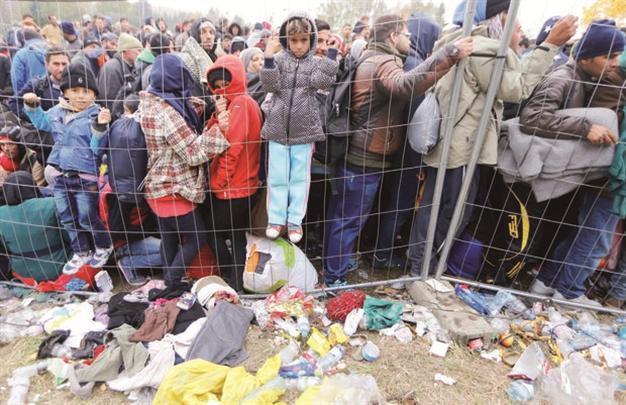Fences can’t solve Europe’s migrant crisis, says Germany as Austria announces fence plans
BERLIN/VIENNA/ANKARA

REUTERS photo
Europe’s migrant crisis cannot be solved with the construction of fences or walls at borders, Germany has said after Austria announced plans to erect fences on its border with Slovenia to slow the influx.“We do not believe that the current migrant crisis that Europe is facing can be resolved with the building of fences or walls,” government spokesman Steffen Seibert said on Oct. 28. “We can only solve it if we as Europe take the same line, if we act together... if we see this task as a common one.”
Earlier in the day, speaking in Vienna, Austrian Interior Minister Johanna Mikl-Leitner said the fence along her country’s border with Slovenia was “about ensuring an orderly, controlled entry into our country, not about shutting down the border.”
Both Austria and Slovenia are part of the passport-free Schengen zone and have been key transit countries for tens of thousands of refugees and migrants desperately seeking to reach northern Europe via the Balkans.
“This is about ensuring an orderly, controlled entry into our country, not about shutting down the border,” she told public broadcaster Oe1.
The politician of the conservative Austrian People’s Party (ÖVP) party added that the situation risked escalating as people were forced to wait in freezing temperatures for hours before being allowed to cross from one nation into another.
“We know that in recent days and weeks individual groups of migrants have become more impatient, aggressive and emotional. If groups of people push from behind, with children and women stuck in-between, you need stable, massive measures,” Mikl-Leitner said.
On Oct. 27, the minister had already hinted at the fence during a visit to the Spielfeld border crossing, saying she was considering “structural measures” to be implemented at the checkpoint.
Last week, she drew strong criticism from opposition members for saying that it was time for the EU to “build fortress Europe.”
More than 700,000 people fleeing war and misery have reached Europe’s Mediterranean shores so far this year, with a majority coming from Syria, Afghanistan and Iraq.
From Greece, they begin a grueling trek through the western Balkans and central Europe in the hope of reaching the EU’s economic powerhouse Germany, the preferred destination for many migrants.
The EU has pledged at least 1 billion euros for Syrian refugees mostly in Turkey, Jordan and Lebanon and says it is willing to give Ankara funds so that Syrians can apply for asylum in Europe directly from camps on Turkish soil.
There are more than 2,100,000 registered Syrian refugees in Turkey, while around 250,000 of them have been residing in camps built by the Disaster and Emergency Management Presidency (AFAD).
Those 2,138,977 Syrians have been given “biometric identity cards,” meaning they have been granted the “status of temporary protection.” Turkey has so far spent $8 billion on the refugees, while having received just $418 million in assistance from international organizations.
Some 258,472 Syrians have been living in 25 camps built and run by AFAD, while 15,000 Iraqis, including 6,000 Yazidi refugees, also stay in those camps. Syrians staying outside of camps are located in all 81 provinces of Turkey.
















